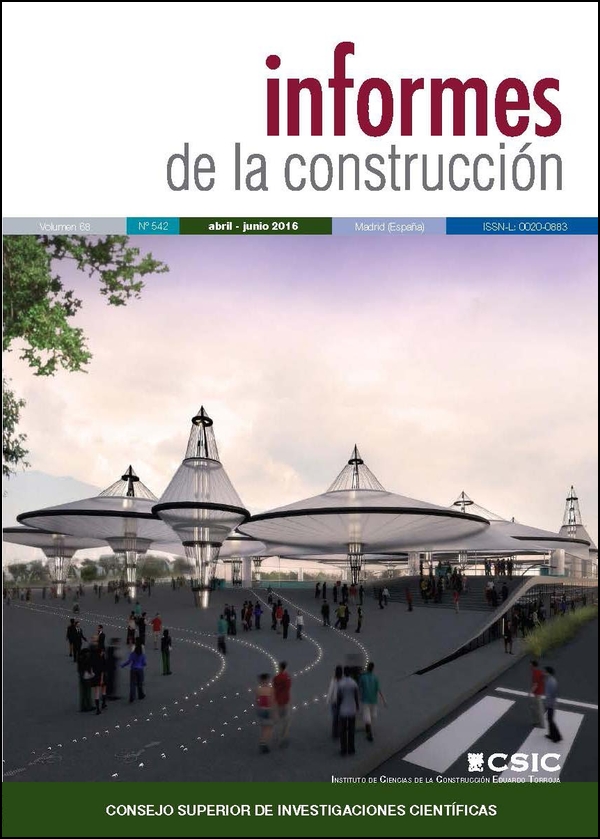Architecture, urbanism and civil and military public works in the Geographic Atlas of Spain (1804) of Tomas Lopez
DOI:
https://doi.org/10.3989/ic.15.075Keywords:
Architecture, urbanism, civilian and military public works, Tomas Lopez, Geographic Atlas of Spain, representationAbstract
This manuscript presents a novel analysis that deals about how architecture, urban planning and civil and military public works are represented in Geographic Atlas of Spain 1804 (AGE) of Tomas Lopez. For this it has been characterized different map symbols appearing on maps, which are the benchmarks for analysis and transmit accurate information on the shape and meaning of what is represented. So, more than one hundred different symbols were found. This gives an idea of the great detail and richness of the information contained in AGE. A deeper analysis shows that eighteen of them are equivalent to other previous cartographic symbols. These were from Chevalier, D’Anville teacher, who in turn was the teacher Thomas Lopez in Paris. Additionally, we found that there are several symbols with similarity to their corresponding of the Ordinances of the Royal Corps of Engineers from 1803.
Downloads
References
(1) Manzano Agugliaro, F., Martínez García, J., San Antonio Gomez, J. C. (2012). GIS analysis of the accuracy of Tomas Lopez's historical cartography in the canary islands (1742-1746). Scientific Research and Essays, 7(2): 199-210.
(2) Chías, P., Abad, T. (2012). El arte de describir el territorio: mapas y planos históricos en torno al puente de Alcántara (Cáceres, España). Informes de la Construcción, 64 (Extra): 121-134.
(3) San Antonio Gómez, C., Velilla, C., Manzano Agugliaro, F. (2011). Tomas Lopez's geographic atlas of Spain in the Peninsular war: A methodology for determining errors. Survey Review, 43(319): 30-44. http://dx.doi.org/10.1179/003962610X12747001420861
(4) López Gómez, A., Manso Porto, C. (2006). Cartografía del siglo XVIII, Tomás López en la Real Academia de la Historia, p. 521. Madrid: Real Academia de la Historia.
(5) Sanz Hermida, J. M. (1992). Atlas Geográphico del Reyno de España e islas adyacentes. Salamanca: Europa Ediciones de Arte.
(6) Hernando, A. (2005). El Atlas Geográfico de España (1804) producido por Tomás López. Madrid: Instituto Geográfico Nacional. Centro Nacional de Información Geográfica.
(7) Clark, P. K., Jones, Y. (1974, 29 de abril). British military map making in the Peninsular war. En VII Conferencia Internacional de Cartografía ICA, p. 106. Madrid: International Cartographic Association.
(8) Nú-ez de las Cuevas, R. (2012). El poder de los mapas. Estudios Geográficos, 73(273): 587-588.
(9) Manzano Agugliaro, F., Fernández Sánchez, J. S., San Antonio Gómez, C. (2013). Mapping the whole errors of Tomas Lopez's geographic atlas of Spain (1804). Journal of Maps, 9(4): 617-622. http://dx.doi.org/10.1080/17445647.2013.842188
(10) Manzano Agugliaro, F., San Antonio Gómez, C., López, S., Montoya, F. G., Gil, C. (2013). Pareto-based evolutionary algorithms for the calculation of transformation parameters and accuracy assessment of historical maps. Computers and Geosciences, 57: 124-132. http://dx.doi.org/10.1016/j.cageo.2013.04.010
(11) Marcel, G. (1908). El geógrafo Tomás López y sus obras: ensayo de biografía y de cartografía. Boletín de la Real Academia de la Historia, LIII: 452-453. Madrid.
(12) Capel, H. (1982). Geografía y matemáticas en la España del siglo xviii. Barcelona: Oikos-Tau.
(13) Liter Mayayo, C., Sanchís Ballester, F. (1998). Tomás López y sus colaboradores. Madrid: Biblioteca Nacional.
(14) San Antonio Gómez, C. (2005). Castillos y ciudades fortificadas en la América Española: Planos del siglo xviii. En Ribera, F. (ed.), Luci tra le rocce, vol. I, pp. 100-109. Firenze: Alinea Editrice S.R.L.
(15) San Antonio Gómez, C. (2006, 1-2 de junio). Metodología para el análisis gráfico de la cartografía histórica. En Congreso Internacional XVIII Ingegraf, pp. 81-95. Barcelona: Universidad Politécnica de Catalu-a.
(16) Alinhac, G. (1965). Histoire de la Cartographie. París: Institut Géographique National.
(17) Chevalier M. (1707). Sur la Maniere de lever la carte d'un pays. Histoire de l'Academie Royal de Sciences, pp. 113-116. París.
(18) Manzano Agugliaro, F., Manzano Agugliaro, G., San Antonio Gómez, C. (2005, 1-3 de junio). El levantamiento topográfico y la cartografía en el siglo xviii: el método de la topografía eclesiástica. En Congreso Internacional XVII Ingegraf-XV ADM, pp. 284-294. Sevilla: Universidad de Sevilla.
(19) González Tascón, I. (1992). Ingeniería española en ultramar (siglos xvi-xix), vol. I, p. 85. Madrid: Colegio de Ingenieros de Caminos, Canales y Puertos.
(20) Paladini Cuadrado, Á. (1989). Cartografia militar española de Indias. Militaria, Revista de Cultura Militar, 1: 57-89. Madrid: Ed. Univ. Complutense.
Published
How to Cite
Issue
Section
License
Copyright (c) 2016 Consejo Superior de Investigaciones Científicas (CSIC)

This work is licensed under a Creative Commons Attribution 4.0 International License.
© CSIC. Manuscripts published in both the print and online versions of this journal are the property of the Consejo Superior de Investigaciones Científicas, and quoting this source is a requirement for any partial or full reproduction.
All contents of this electronic edition, except where otherwise noted, are distributed under a Creative Commons Attribution 4.0 International (CC BY 4.0) licence. You may read the basic information and the legal text of the licence. The indication of the CC BY 4.0 licence must be expressly stated in this way when necessary.
Self-archiving in repositories, personal webpages or similar, of any version other than the final version of the work produced by the publisher, is not allowed.















